How Do the Multi-Temporal Centroid Trajectories of Urban Heat Island Correspond to Impervious Surface Changes: A Case Study in Wuhan, China
Abstract
1. Introduction
2. Study Area and Datasets
2.1. Wuhan, China
2.2. Land Surface Temperature (LST) Products
2.3. Impervious Surface (IS) Maps
2.4. Methodology
2.4.1. Multi-Task Gaussian Process (MTGP) Model for Typical LST Patterns Extraction
2.4.2. LST Grading
2.5. Weighted Center of LST and IS
2.5.1. Impervious Surface Fraction Weighted Center (ISFWC)
2.5.2. LST Weighted Center (LSTWC)
2.6. Quantification of Spatiotemporal Dynamics and Relationships between LST and IS
2.6.1. Urban Heat Island (UHI) Ratio Index
2.6.2. Sprawl Rate
2.6.3. Coupling Indicators between IS and LST
2.6.4. Impervious Surface Contribution Index
3. Results and Discussion
3.1. Impervious Surfacve Expansions within Wuhan
3.2. Spatiotemporal Dynamics of LST Patterns
3.3. The Multi-Scale Correlations between LST and IS
3.4. Implications and Limitations
4. Conclusions
- (1)
- The hot thermal landscapes of the study area have significantly expanded from 276.09 to 531.91 km2 and the impervious surfaces has expanded by 407.43 km2 (from 270.75 to 678.18 km2) at the city scale. There is a positive linear relationship between the expansions of hot thermal landscape and IS (R2 = 0.969).
- (2)
- URIs have increased from 0.33 to 0.55, indicating the UHI effect of the study area have become more intensive in the period of 2002–2017. The increase of URIs is highly correlated to the expansion of IS at the city scale (R2 = 0.927).
- (3)
- The most expansion of hot thermal landscape has been witnessed in the east, southeast and northeast sub-regions, which is quite consistent with the IS expansions at the sub-region scale.
- (4)
- At the city scale, the coupling relationship between LST and IS is quite strong (cos α larger than 0.709 and distances between LSTWCs and ISFWCs shorter than 3948.09 meters in general). However, the coupling relationship has been weakened in 2002-2014, afterwards strengthened in 2017.
- (5)
- At the sub-region scale, the warming contribution of impervious surfaces has been examined to be the external forcing of the movements of LSTWC. Specifically, LSTWC tend to move towards the sub-region with the most significant variation of impervious surfaces contribution index. Implications and suggestions are available for the decision makers to steer land use/land cover and allocate urban sprawl based on the findings of this study.
Author Contributions
Funding
Acknowledgments
Conflicts of Interest
References
- Zhou, L.; Dickinson, R.E.; Tian, Y.; Fang, J.; Li, Q.; Kaufmann, R.K.; Tucker, C.J.; Myneni, R.B. Evidence for a significant urbanization effect on climate in china. Proc. Natl. Acad. Sci. USA 2004, 101, 9540. [Google Scholar] [CrossRef] [PubMed]
- Sun, Y.; Zhang, X.; Ren, G.; Zwiers, F.W.; Hu, T. Contribution of urbanization to warming in china. Nat. Clim. Chang. 2016, 6, 706. [Google Scholar] [CrossRef]
- Huang, F.; Zhan, W.; Wang, Z.; Wang, K.; Chen, J.M.; Liu, Y.; Lai, J.; Ju, W. Positive or negative? Urbanization-induced variations in diurnal skin-surface temperature range detected using satellite data. J. Geophys. Res. Atmos. 2017, 122, 13,229–13,244. [Google Scholar] [CrossRef]
- Grimm, N.B.; Faeth, S.H.; Golubiewski, N.E.; Redman, C.L.; Wu, J.; Bai, X.; Briggs, J.M. Global change and the ecology of cities. Science 2008, 319, 756. [Google Scholar] [CrossRef] [PubMed]
- Oke, T.R. Street design and urban canopy layer climate. Energy Build. 1988, 11, 103–113. [Google Scholar] [CrossRef]
- Zhou, D.; Xiao, J.; Bonafoni, S.; Berger, C.; Deilami, K.; Zhou, Y.; Frolking, S.; Yao, R.; Qiao, Z.; Sobrino, A.J. Satellite remote sensing of surface urban heat islands: Progress, challenges and perspectives. Remote Sens. 2018, 11, 48. [Google Scholar] [CrossRef]
- Chirico, F. Comments on “climate change and public health: A small frame obscures the picture”. New Solut. A J. Environ. Occup. Health Policy 2018, 28, 5–7. [Google Scholar] [CrossRef]
- Chirico, F.; Magnavita, N. The significant role of health surveillance in the occupational heat stress assessment. Int. J. Biometeorol. 2019, 63, 193–194. [Google Scholar] [CrossRef] [PubMed]
- Quan, J. Multi-temporal effects of urban forms and functions on urban heat islands based on local climate zone classification. Int. J. Environ. Res. Public Health 2019, 16, 2140. [Google Scholar] [CrossRef]
- Liu, H.; Zhan, Q.; Yang, C.; Wang, J. The multi-timescale temporal patterns and dynamics of land surface temperature using ensemble empirical mode decomposition. Sci. Total Environ. 2019, 652, 243–255. [Google Scholar] [CrossRef]
- Zhao, S.; Liu, S.; Zhou, D. Prevalent vegetation growth enhancement in urban environment. Proc. Natl. Acad. Sci. USA 2016, 113, 6313. [Google Scholar] [CrossRef] [PubMed]
- Li, H.; Meier, F.; Lee, X.; Chakraborty, T.; Liu, J.; Schaap, M.; Sodoudi, S. Interaction between urban heat island and urban pollution island during summer in berlin. Sci. Total Environ. 2018, 636, 818–828. [Google Scholar] [CrossRef] [PubMed]
- Voogt, J.; Oke, T. Thermal remote sensing of urban climates. Remote Sens. Environ. 2003, 86, 370–384. [Google Scholar] [CrossRef]
- Quan, J.; Chen, Y.; Zhan, W.; Wang, J.; Voogt, J.; Wang, M. Multi-temporal trajectory of the urban heat island centroid in beijing, china based on a gaussian volume model. Remote Sens. Environ. 2014, 149, 33–46. [Google Scholar] [CrossRef]
- Weng, Q.; Lu, D. A sub-pixel analysis of urbanization effect on land surface temperature and its interplay with impervious surface and vegetation coverage in indianapolis, united states. Int. J. Appl. Earth Obs. Geoinf 2008, 10, 68–83. [Google Scholar] [CrossRef]
- Xu, J.; Zhao, Y.; Zhong, K.; Zhang, F.; Liu, X.; Sun, C. Measuring spatio-temporal dynamics of impervious surface in guangzhou, china, from 1988 to 2015, using time-series landsat imagery. Sci. Total Environ. 2018, 627, 264–281. [Google Scholar] [CrossRef]
- Bai, X.; Dawson, R.; Ürge-Vorsatz, D.; Delgado, G.; Barau, A.S.; Dhakal, S.; Dodman, D.; Leonardsen, L.; Masson-Delmotte, V.; Roberts, D.; et al. Six research priorities for cities and climate change. Nature 2018, 555. [Google Scholar] [CrossRef]
- Shao, Z.; Fu, H.; Li, D.; Altan, O.; Cheng, T. Remote sensing monitoring of multi-scale watersheds impermeability for urban hydrological evaluation. Remote Sens. Environ. 2019, 232, 111338. [Google Scholar] [CrossRef]
- Hao, P.; Niu, Z.; Zhan, Y.; Wu, Y.; Wang, L.; Liu, Y. Spatiotemporal changes of urban impervious surface area and land surface temperature in beijing from 1990 to 2014. GIScience Remote. Sens. 2016, 53, 63–84. [Google Scholar] [CrossRef]
- Wang, J.; Qingming, Z.; Guo, H.; Jin, Z. Characterizing the spatial dynamics of land surface temperature–impervious surface fraction relationship. Int. J. Appl. Earth Obs. Geoinf. 2016, 45, 55–65. [Google Scholar] [CrossRef]
- Shen, H.; Huang, L.; Zhang, L.; Wu, P.; Zeng, C. Long-term and fine-scale satellite monitoring of the urban heat island effect by the fusion of multi-temporal and multi-sensor remote sensed data: A 26-year case study of the city of wuhan in china. Remote Sens. Environ. 2016, 172, 109–125. [Google Scholar] [CrossRef]
- Xu, H.; Lin, D.; Tang, F. The impact of impervious surface development on land surface temperature in a subtropical city: Xiamen, china. Int. J. Climatol. 2013, 33, 1873–1883. [Google Scholar] [CrossRef]
- Mathew, A.; Khandelwal, S.; Kaul, N. Spatial and temporal variations of urban heat island effect and the effect of percentage impervious surface area and elevation on land surface temperature: Study of chandigarh city, india. Sustain. Cities Soc. 2016, 26, 264–277. [Google Scholar] [CrossRef]
- Liu, Y.; Peng, J.; Wang, Y. Diversification of land surface temperature change under urban landscape renewal: A case study in the main city of shenzhen, china. Remote Sens. 2017, 9, 919. [Google Scholar] [CrossRef]
- Li, W.; Cao, Q.; Lang, K.; Wu, J. Linking potential heat source and sink to urban heat island: Heterogeneous effects of landscape pattern on land surface temperature. Sci. Total Environ. 2017, 586, 457–465. [Google Scholar] [CrossRef] [PubMed]
- Yang, J.; Su, J.; Xia, J.C.; Jin, C.; Li, X.; Ge, Q. The impact of spatial form of urban architecture on the urban thermal environment: A case study of the zhongshan district, dalian, china. IEEE J. Sel. Top. Appl. Earth Obs. Remote. Sens. 2018, 11, 2709–2716. [Google Scholar] [CrossRef]
- Pan, Z.; Wang, G.; Hu, Y.; Cao, B. Characterizing urban redevelopment process by quantifying thermal dynamic and landscape analysis. Habitat Int. 2019, 86, 61–70. [Google Scholar] [CrossRef]
- Weng, Q.; Fu, P. Modeling diurnal land temperature cycles over los angeles using downscaled goes imagery. ISPRS J. Photogramm. Remote Sens. 2014, 97, 78–88. [Google Scholar] [CrossRef]
- Liu, H.; Zhan, Q.; Gao, S.; Yang, C. Seasonal variation of the spatially non-stationary association between land surface temperature and urban landscape. Remote Sens. 2019, 11, 1016. [Google Scholar] [CrossRef]
- Weng, Q.; Fu, P. Modeling annual parameters of clear-sky land surface temperature variations and evaluating the impact of cloud cover using time series of landsat tir data. Remote Sens. Environ. 2014, 140, 267–278. [Google Scholar] [CrossRef]
- Liu, Z.; Zhan, W.; Lai, J.; Hong, F.; Quan, J.; Bechtel, B.; Huang, F.; Zou, Z. Balancing prediction accuracy and generalization ability: A hybrid framework for modelling the annual dynamics of satellite-derived land surface temperatures. ISPRS J. Photogramm. Remote Sens. 2019, 151, 189–206. [Google Scholar] [CrossRef]
- Wang, J.; Zhan, Q.; Guo, H. The morphology, dynamics and potential hotspots of land surface temperature at a local scale in urban areas. Remote Sens. 2016, 8, 18. [Google Scholar] [CrossRef]
- Liu, H.; Zhan, Q.; Yang, C.; Wang, J. Characterizing the spatio-temporal pattern of land surface temperature through time series clustering: Based on the latent pattern and morphology. Remote Sens. 2018, 10, 654. [Google Scholar] [CrossRef]
- Qiao, Z.; Tian, G.; Xiao, L. Diurnal and seasonal impacts of urbanization on the urban thermal environment: A case study of beijing using modis data. ISPRS J. Photogramm. Remote Sens. 2013, 85, 93–101. [Google Scholar] [CrossRef]
- Quan, J.; Zhan, W.; Ma, T.; Du, Y.; Guo, Z.; Qin, B. An integrated model for generating hourly landsat-like land surface temperatures over heterogeneous landscapes. Remote Sens. Environ. 2018, 206, 403–423. [Google Scholar] [CrossRef]
- Huang, F.; Zhan, W.; Voogt, J.; Hu, L.; Wang, Z.; Quan, J.; Ju, W.; Guo, Z. Temporal upscaling of surface urban heat island by incorporating an annual temperature cycle model: A tale of two cities. Remote Sens. Environ. 2016, 186, 1–12. [Google Scholar] [CrossRef]
- Rajasekar, U.; Weng, Q. Urban heat island monitoring and analysis using a non-parametric model: A case study of indianapolis. ISPRS J. Photogramm. Remote Sens. 2009, 64, 86–96. [Google Scholar] [CrossRef]
- Zhao, M.; Cai, H.; Qiao, Z.; Xu, X. Influence of urban expansion on the urban heat island effect in shanghai. Int. J. Geogr. Inf. Sci. 2016, 30, 2421–2441. [Google Scholar] [CrossRef]
- Qiao, Z.; Tian, G.; Zhang, L.; Xu, X. Influences of urban expansion on urban heat island in beijing during 1989–2010. Adv. Meteorol. 2014, 2014, 11. [Google Scholar] [CrossRef]
- Weng, Q.; Firozjaei, M.K.; Sedighi, A.; Kiavarz, M.; Alavipanah, S.K. Statistical analysis of surface urban heat island intensity variations: A case study of babol city, iran. GIScience Remote Sens. 2019, 56, 576–604. [Google Scholar] [CrossRef]
- Yang, Z.; Chen, Y.; Qian, Q.; Wu, Z.; Zheng, Z.; Huang, Q. The coupling relationship between construction land expansion and high-temperature area expansion in china’s three major urban agglomerations. Int. J. Remote Sens. 2019, 40, 6680–6699. [Google Scholar] [CrossRef]
- Huang, Q.; Huang, J.; Yang, X.; Fang, C.; Liang, Y. Quantifying the seasonal contribution of coupling urban land use types on urban heat island using land contribution index: A case study in wuhan, china. Sustain. Cities Soc. 2019, 44, 666–675. [Google Scholar] [CrossRef]
- Stone, B.; Vargo, J.; Habeeb, D. Managing climate change in cities: Will climate action plans work? Landsc. Urban Plan. 2012, 107, 263–271. [Google Scholar] [CrossRef]
- Gong, P.; Li, X.; Zhang, W. 40-year (1978–2017) human settlement changes in china reflected by impervious surfaces from satellite remote sensing. Sci. Bull. 2019, 64, 756–763. [Google Scholar] [CrossRef]
- Deilami, K.; Kamruzzaman, M.; Liu, Y. Urban heat island effect: A systematic review of spatio-temporal factors, data, methods, and mitigation measures. Int. J. Appl. Earth Obs. Geoinf. 2018, 67, 30–42. [Google Scholar] [CrossRef]
- Wan, Z. New refinements and validation of the modis land-surface temperature/emissivity products. Remote Sens. Environ. 2008, 112, 59–74. [Google Scholar] [CrossRef]
- Wan, Z. New refinements and validation of the collection-6 modis land-surface temperature/emissivity product. Remote Sens. Environ. 2014, 140, 36–45. [Google Scholar] [CrossRef]
- Zoras, S.; Triantafyllou, A.G.; Deligiorgi, D. Atmospheric stability and pm10 concentrations at far distance from elevated point sources in complex terrain: Worst-case episode study. J. Environ. Manag. 2006, 80, 295–302. [Google Scholar] [CrossRef]
- Tomlinson, C.J.; Chapman, L.; Thornes, J.E.; Baker, C.J. Derivation of birmingham’s summer surface urban heat island from modis satellite images. Int. J. Climatol. 2012, 32, 214–224. [Google Scholar] [CrossRef]
- Chapman, L.; Thornes, J.E.; Bradley, A.V. Modelling of road surface temperature from a geographical parameter database. Part 1: Statistical. Meteorol. Appl. 2001, 8, 409–419. [Google Scholar] [CrossRef]
- Pas Quill, F. The estimation of the dispersion of windborne material. Meteorol. Mag. 1961, 90, 33–49. [Google Scholar]
- Li, X.; Gong, P. An “exclusion-inclusion” framework for extracting human settlements in rapidly developing regions of china from landsat images. Remote Sens. Environ. 2016, 186, 286–296. [Google Scholar] [CrossRef]
- Li, X.; Gong, P.; Liang, L. A 30-year (1984–2013) record of annual urban dynamics of beijing city derived from landsat data. Remote Sens. Environ. 2015, 166, 78–90. [Google Scholar] [CrossRef]
- Li, Z.-L.; Tang, B.-H.; Wu, H.; Ren, H.; Yan, G.; Wan, Z.; Trigo, I.F.; Sobrino, J.A. Satellite-derived land surface temperature: Current status and perspectives. Remote Sens. Environ. 2013, 131, 14–37. [Google Scholar] [CrossRef]
- Wang, J.; Kuffer, M.; Sliuzas, R.; Kohli, D. The exposure of slums to high temperature: Morphology-based local scale thermal patterns. Sci. Total Environ. 2019, 650, 1805–1817. [Google Scholar] [CrossRef] [PubMed]
- Coutts, A.M.; Harris, R.J.; Phan, T.; Livesley, S.J.; Williams, N.S.G.; Tapper, N.J. Thermal infrared remote sensing of urban heat: Hotspots, vegetation, and an assessment of techniques for use in urban planning. Remote Sens. Environ. 2016, 186, 637–651. [Google Scholar] [CrossRef]
- Goodchild, M.F. A spatial analytical perspective on geographical information systems. Int. J. Geogr. Inf. Syst. 1987, 1, 327–334. [Google Scholar] [CrossRef]
- Zhang, B.; Xu, G.; Jiao, L.; Liu, J.; Dong, T.; Li, Z.; Liu, X.; Liu, Y. The scale effects of the spatial autocorrelation measurement: Aggregation level and spatial resolution. Int. J. Geogr. Inf. Sci. 2019, 33, 945–966. [Google Scholar] [CrossRef]
- Zhan, Q.; Yue, Y.; Xiao, Y. Evolution of built-up area expansion and verification of planning implementation in wuhan, city. Plan. Rev. 2018, 42(2018), 63–71. [Google Scholar] [CrossRef]
- Shi, L.; Ling, F.; Ge, Y.; Foody, M.G.; Li, X.; Wang, L.; Zhang, Y.; Du, Y. Impervious surface change mapping with an uncertainty-based spatial-temporal consistency model: A case study in wuhan city using landsat time-series datasets from 1987 to 2016. Remote Sens. 2017, 9, 1148. [Google Scholar] [CrossRef]
- Essa, W.; Verbeiren, B.; Van der Kwast, J.; Batelaan, O. Improved distrad for downscaling thermal modis imagery over urban areas. Remote Sens. 2017, 9, 1243. [Google Scholar] [CrossRef]
- Yang, C.; Zhan, Q.; Liu, H.; Ma, R. An ihs-based pan-sharpening method for spectral fidelity improvement using ripplet transform and compressed sensing. Sensors 2018, 18, 3624. [Google Scholar] [CrossRef] [PubMed]
- Lv, J.; Ma, T.; Dong, Z.; Yao, Y.; Yuan, Z. Temporal and spatial analyses of the landscape pattern of wuhan city based on remote sensing images. ISPRS Int. J. Geo-Inf. 2018, 7, 340. [Google Scholar] [CrossRef]
- Liu, H.; Weng, Q. Enhancing temporal resolution of satellite imagery for public health studies: A case study of west nile virus outbreak in los angeles in 2007. Remote Sens. Environ. 2012, 117, 57–71. [Google Scholar] [CrossRef]
- Patz, J.A.; Campbell-Lendrum, D.; Holloway, T.; Foley, J.A. Impact of regional climate change on human health. Nature 2005, 438, 310–317. [Google Scholar] [CrossRef] [PubMed]
- Chirico, F.; Rulli, G. Strategy and methods for the risk assessment of thermal comfort in the workplace. Giornale Ital. Med. Lav Ergon. 2015, 37, 220–233. [Google Scholar]
- Liu, X.; Liu, H.; Fan, H.; Liu, Y.; Ding, G. Influence of heat waves on daily hospital visits for mental illness in jinan, China—A case-crossover study. Int. J. Environ. Res. Public Health 2018, 16, 87. [Google Scholar] [CrossRef] [PubMed]
- Chirico, F.; Magnavita, N. New and old indices for evaluating heat stress in an indoor environment: Some considerations. Comment on Kownacki, L.; Gao, C.; Kuklane, K.; Wierzbicka, A. Heat stress in indoor environments of scandinavian urban areas: A literature review. Int. J. Environ. Res. Public health 2019, 16 (4), 560. doi:10.3390/ijerph16040560. Int. J. Environ. Res. Public Health 2019, 16, 1444. [Google Scholar] [CrossRef]
- Chirico, F.; Taino, G. Climate change and occupational health of outdoor workers: An urgent call to action for european policymakers. Environ. Dis. 2018, 3, 77–79. [Google Scholar] [CrossRef]
- Lo, C.P.; Quattrochi, D.A. Land-use and land-cover change, urban heat island phenomenon, and health implications. Photogramm. Eng. Remote Sens. 2003, 69, 1053–1063. [Google Scholar] [CrossRef]
- Xue, T.; Zhu, T.; Zheng, Y.; Zhang, Q. Declines in mental health associated with air pollution and temperature variability in china. Nat. Commun. 2019, 10, 2165. [Google Scholar] [CrossRef] [PubMed]
- Wang, J.; Ouyang, W. Attenuating the surface urban heat island within the local thermal zones through land surface modification. J. Environ. Manag. 2017, 187, 239–252. [Google Scholar] [CrossRef] [PubMed]
- Yang, J.; Jin, S.; Xiao, X.; Jin, C.; Xia, J.; Li, X.; Wang, S. Local climate zone ventilation and urban land surface temperatures: Towards a performance-based and wind-sensitive planning proposal in megacities. Sustain. Cities Soc. 2019, 47, 101487. [Google Scholar] [CrossRef]
- He, B.-J. Towards the next generation of green building for urban heat island mitigation: Zero uhi impact building. Sustain. Cities Soc. 2019, 50, 101647. [Google Scholar] [CrossRef]
- He, B.-J.; Zhu, J.; Zhao, D.-X.; Gou, Z.-H.; Qi, J.-D.; Wang, J. Co-benefits approach: Opportunities for implementing sponge city and urban heat island mitigation. Land Use Policy 2019, 86, 147–157. [Google Scholar] [CrossRef]
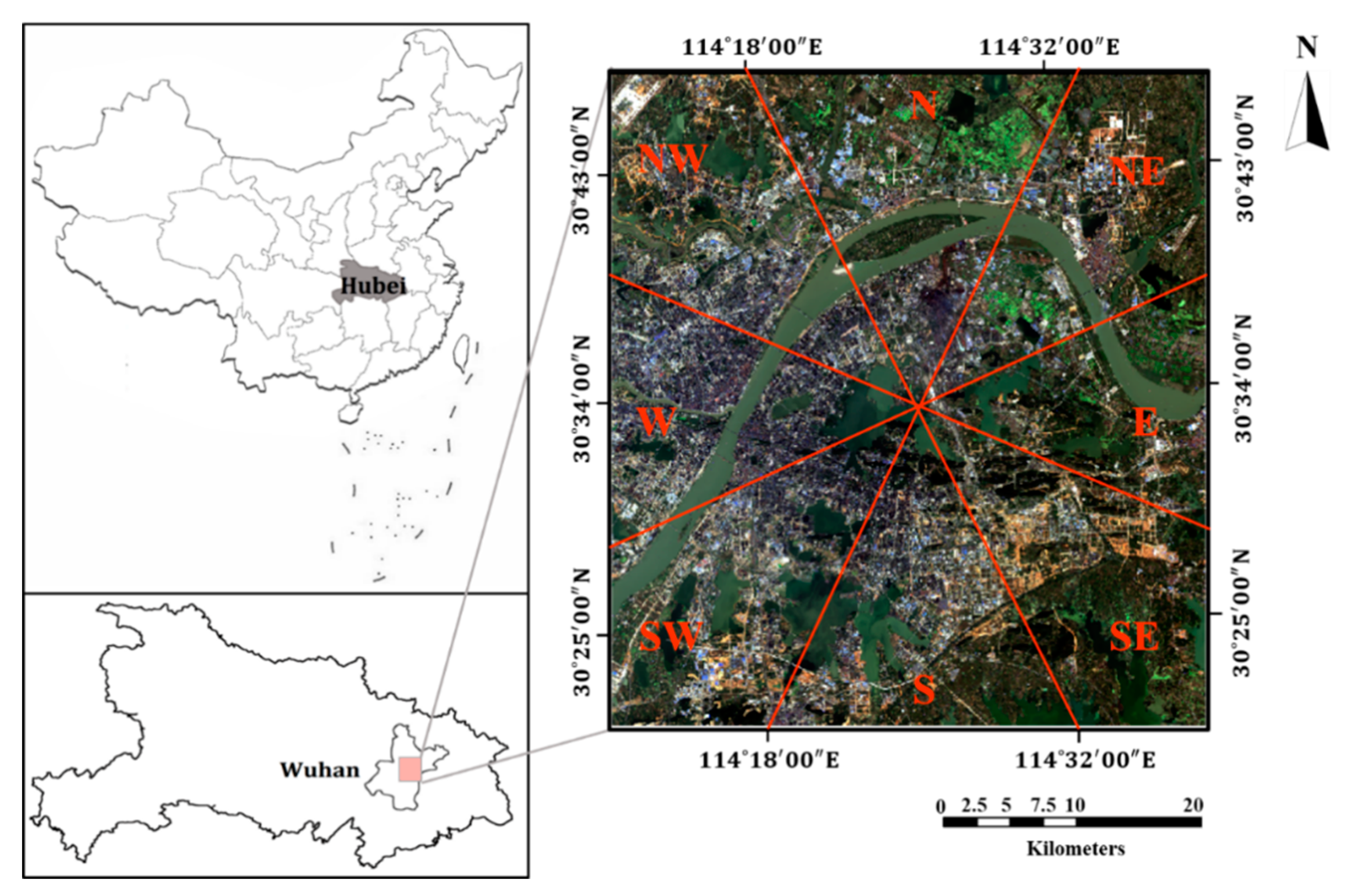
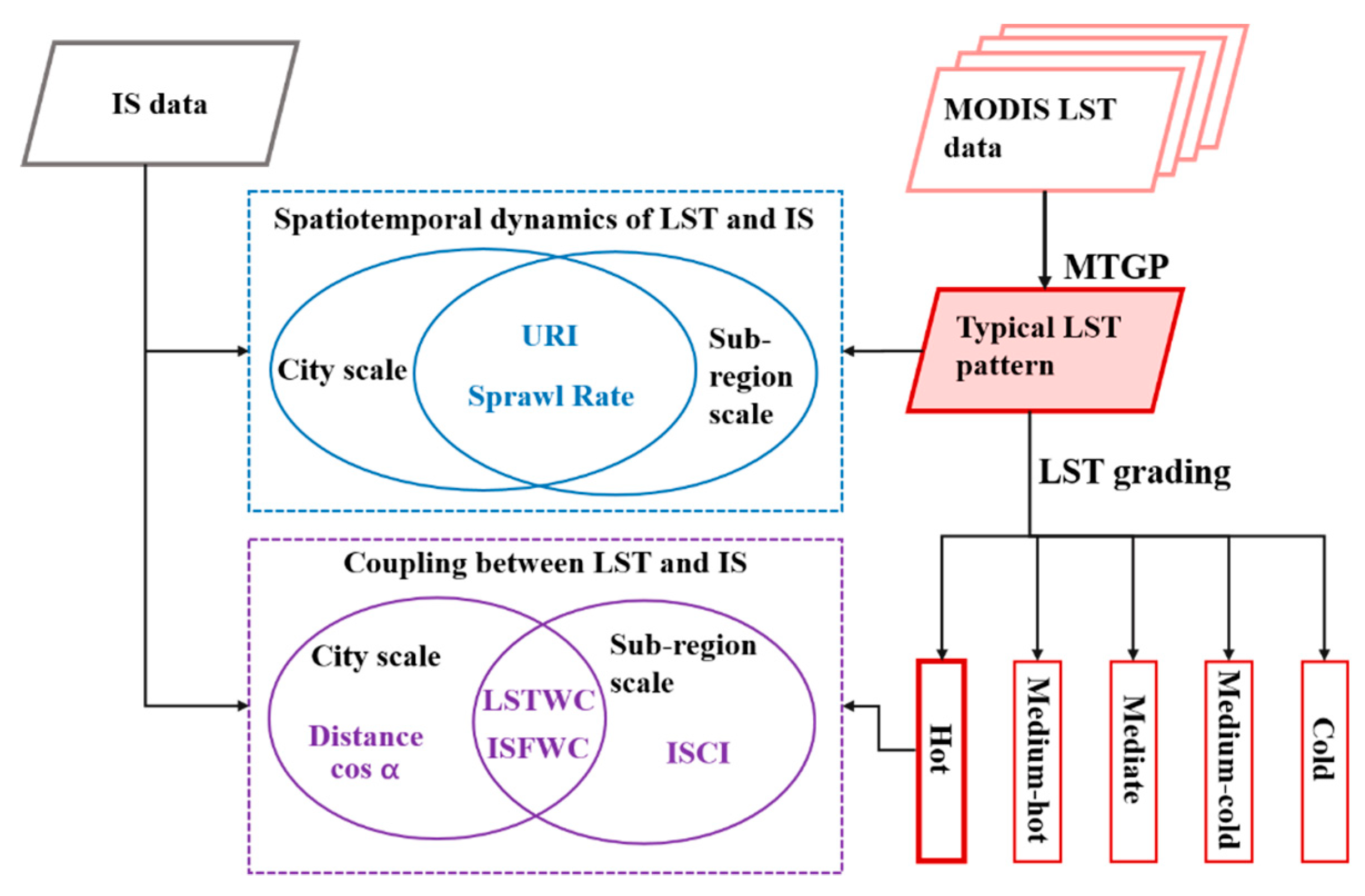
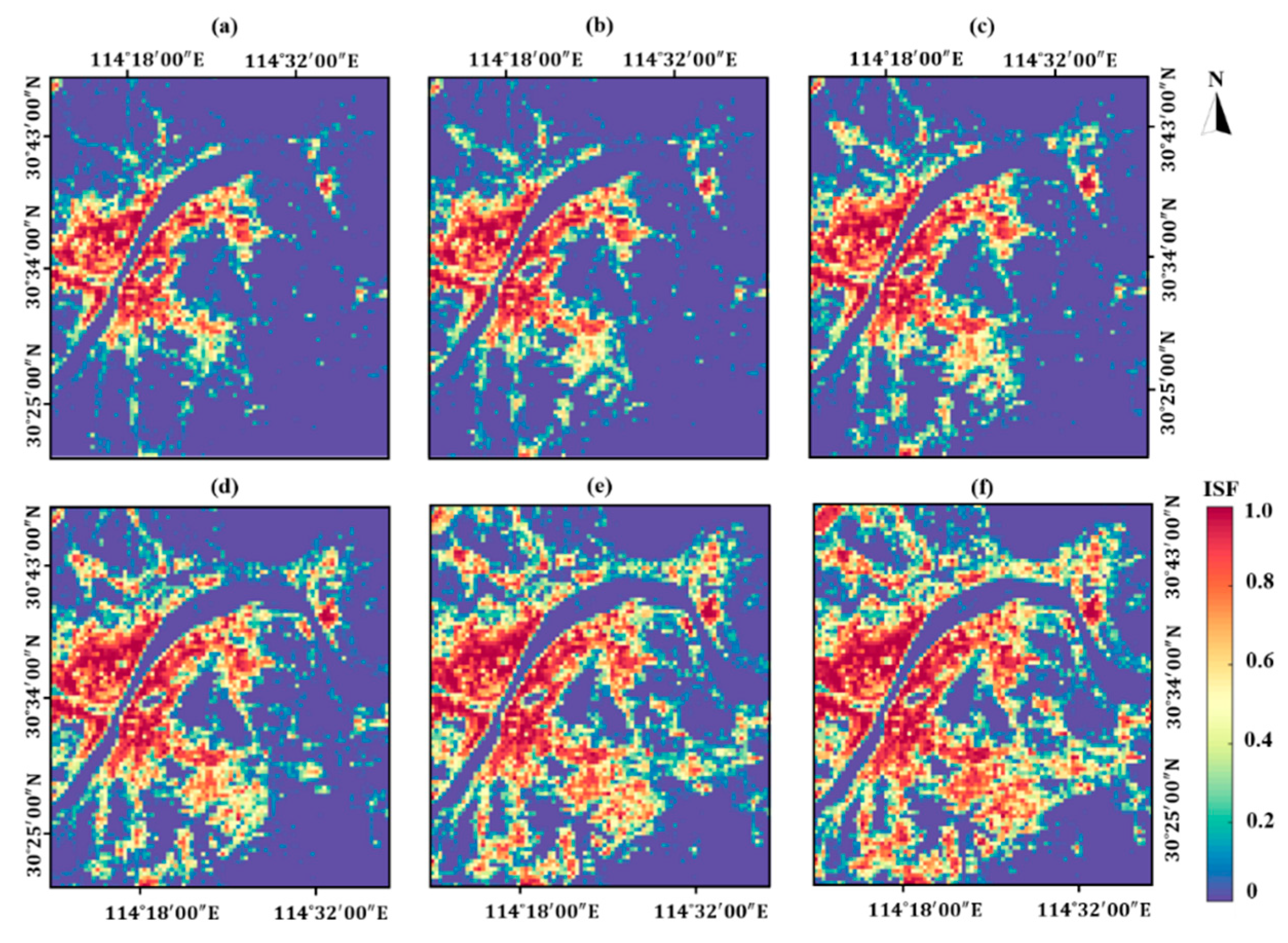
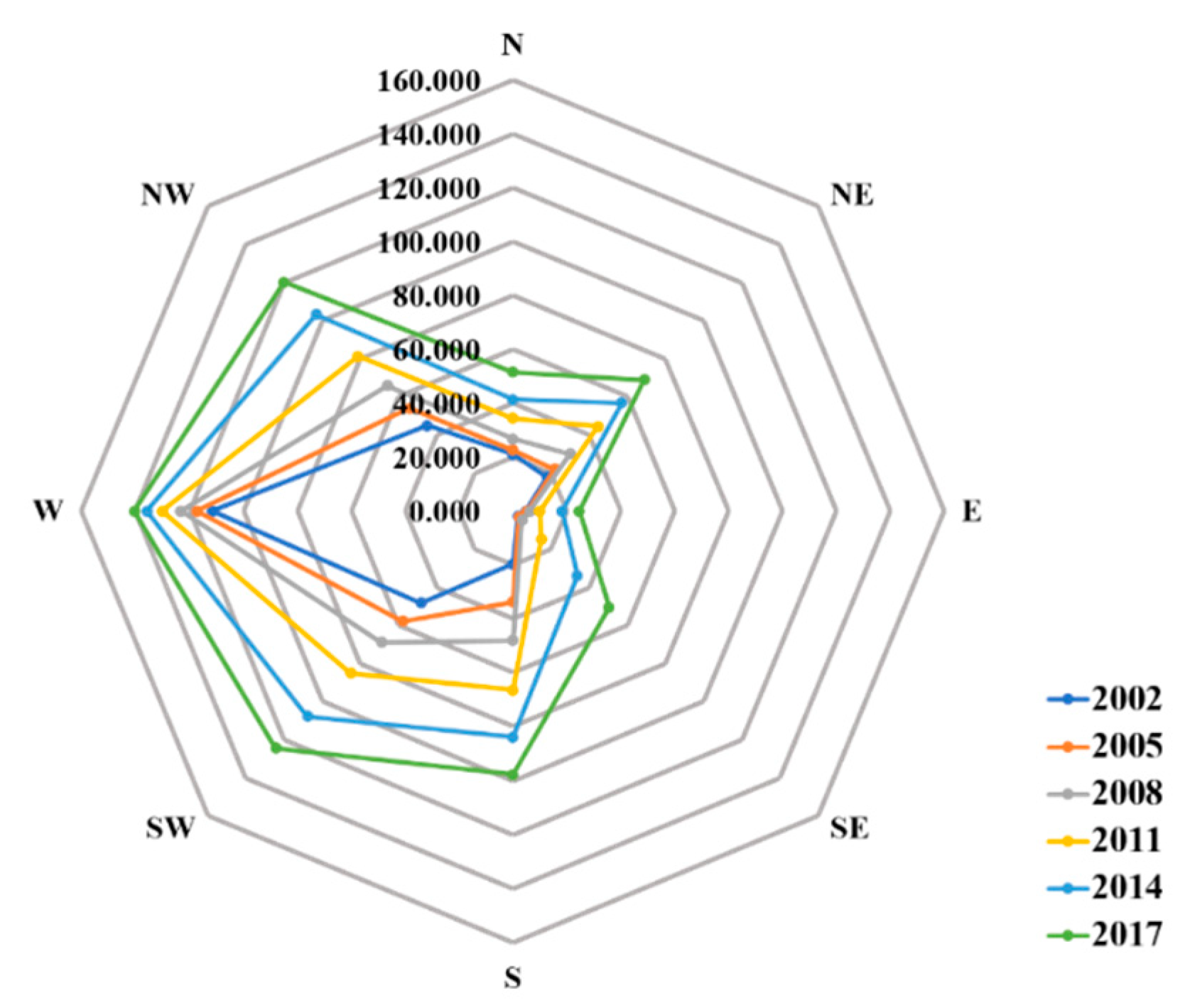
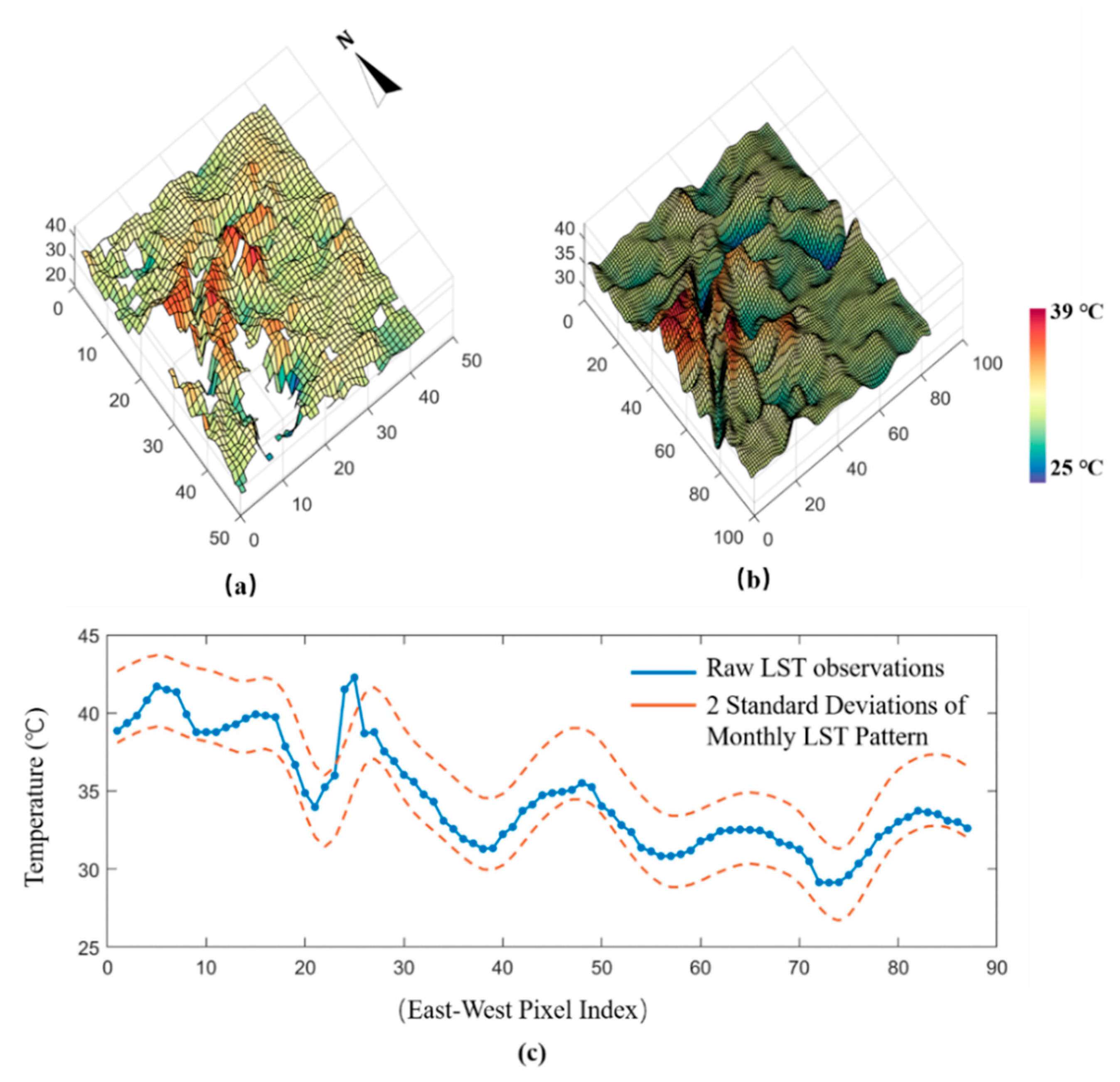
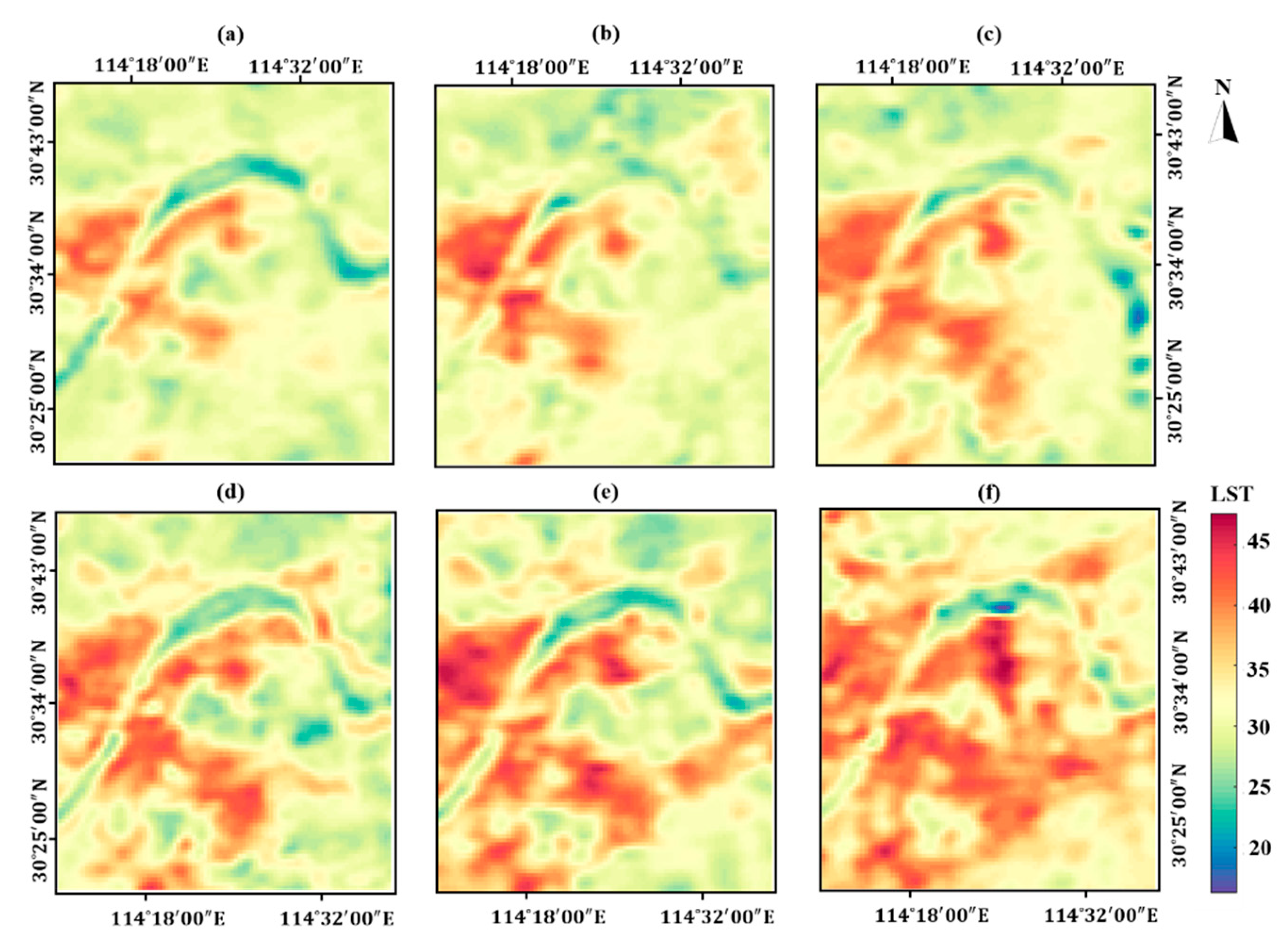
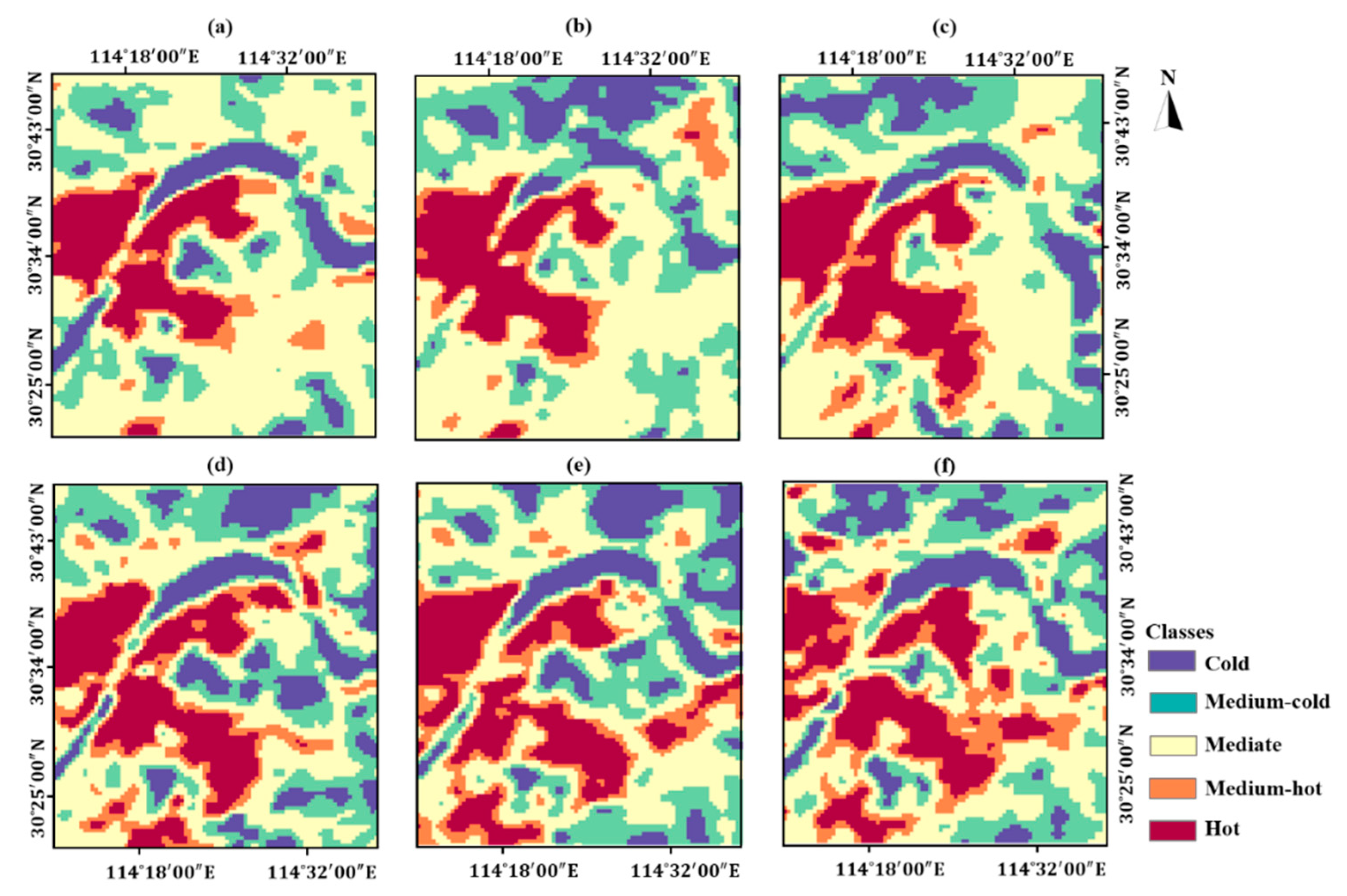
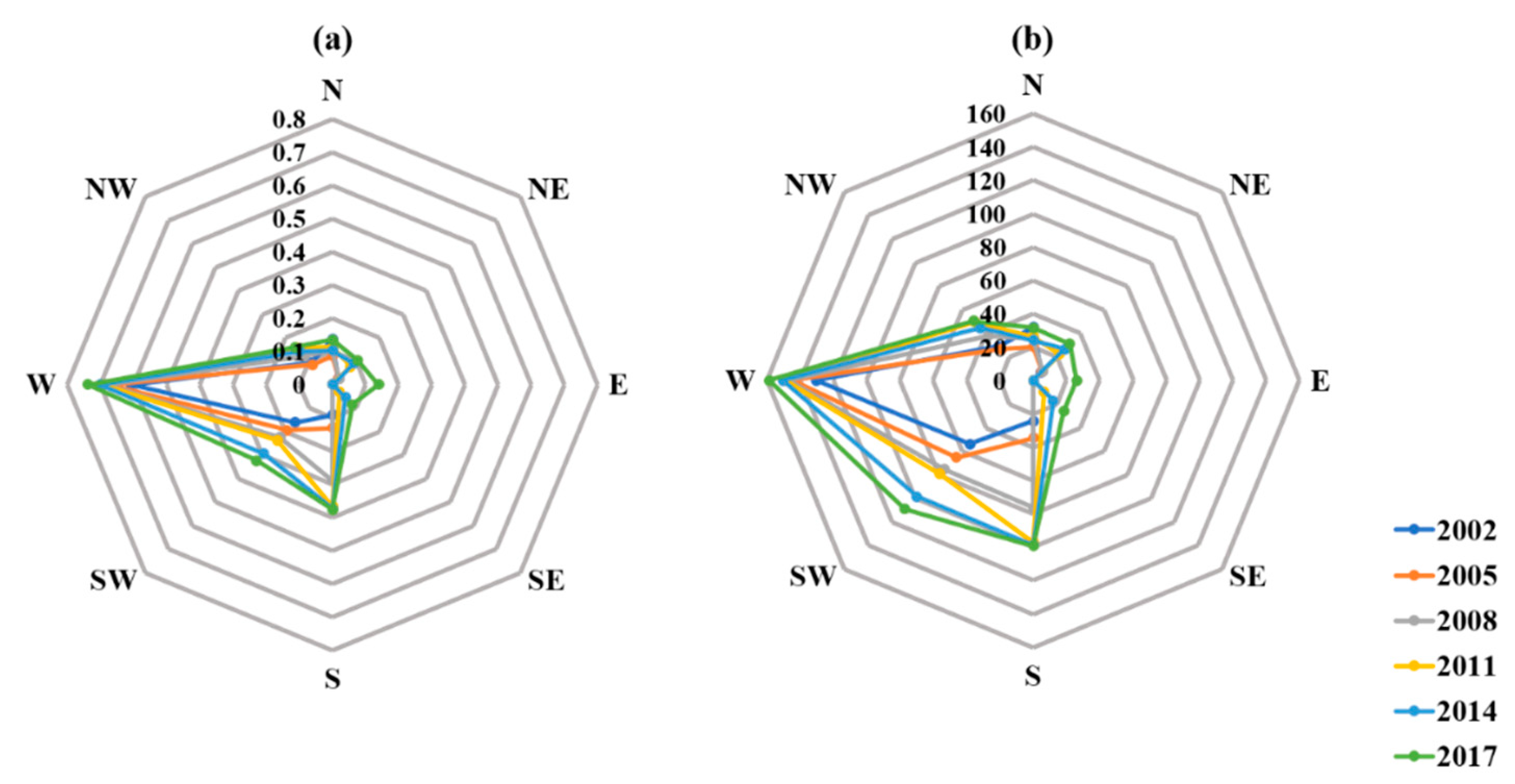
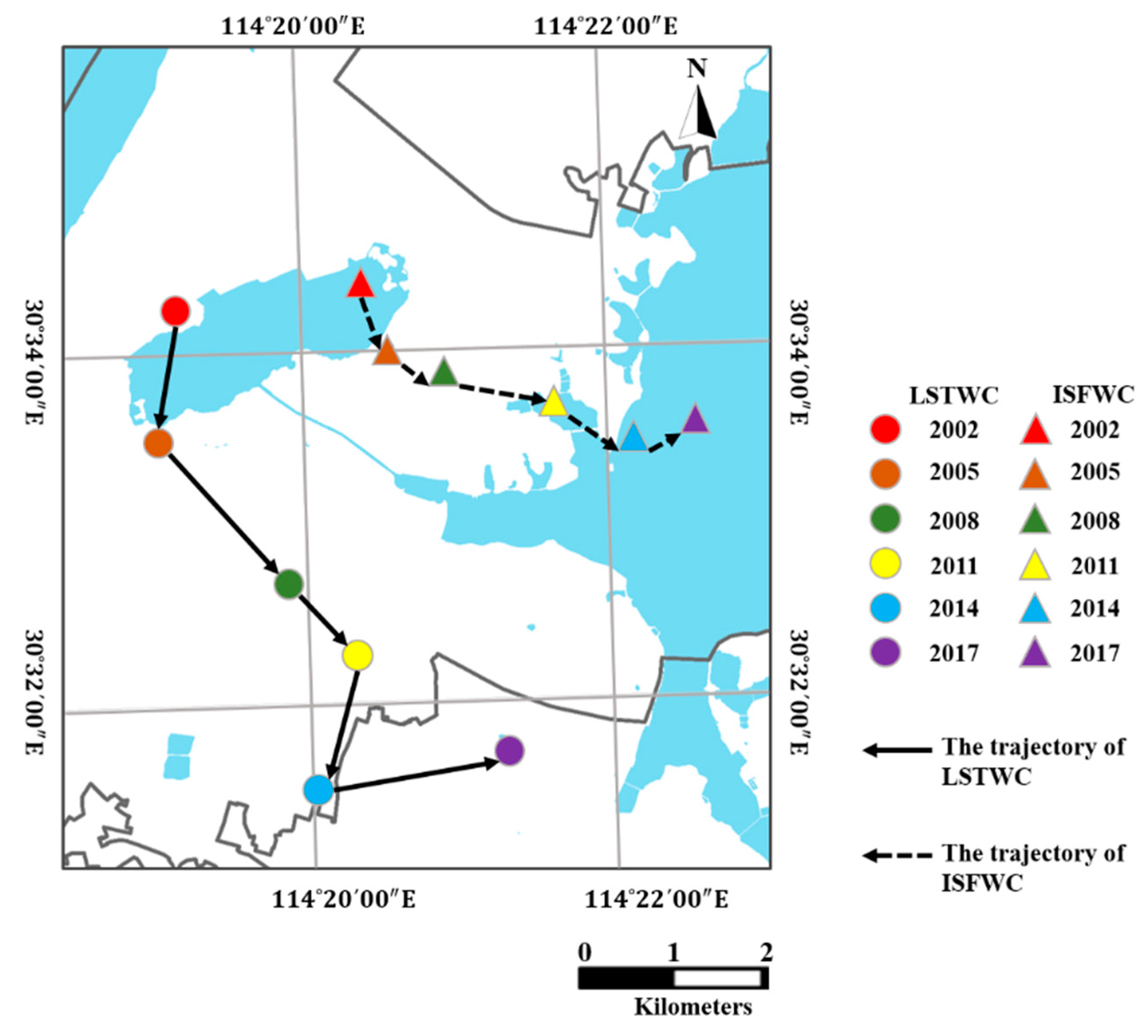
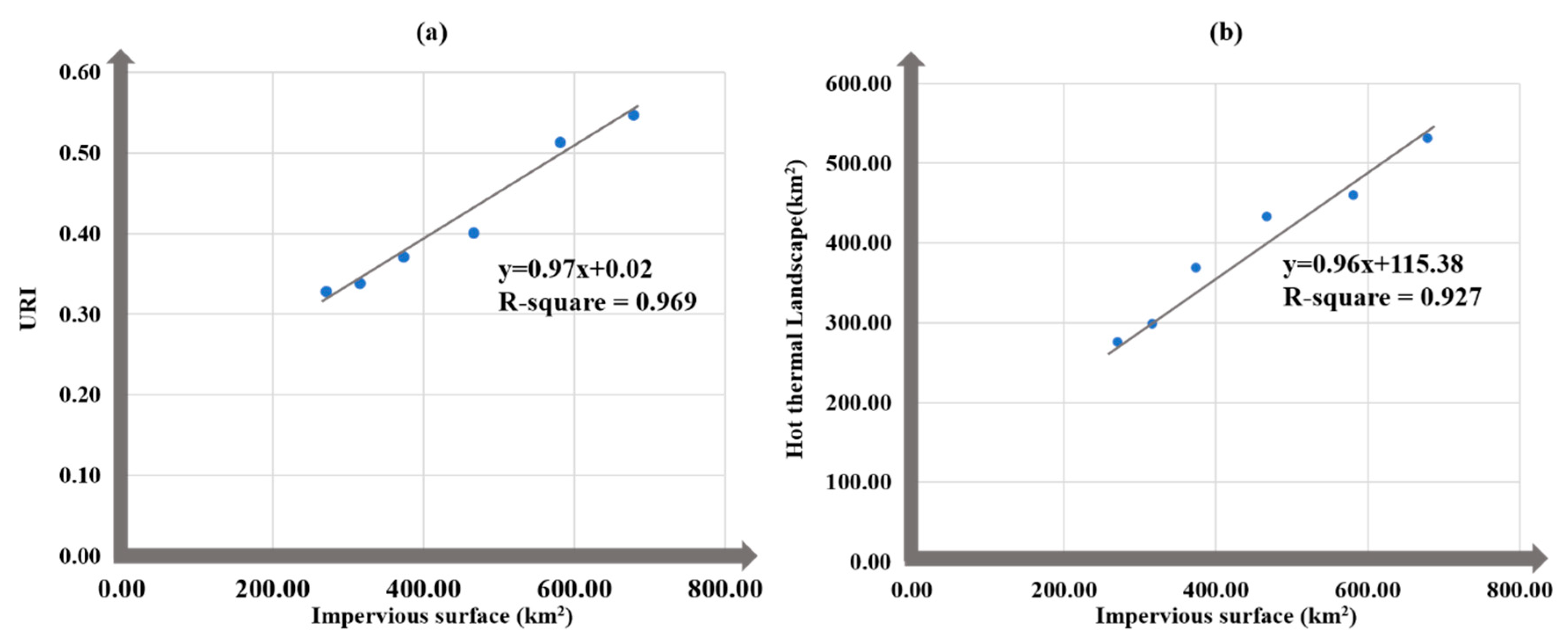
| Year | Date of the Dominant LST Product | Dates of the Auxiliary Products |
|---|---|---|
| 2002 | July 4th | July 12th |
| August 21th | ||
| August 29th | ||
| 2005 | July 12th | July 20th |
| July 28th | ||
| August 5th | ||
| 2008 | August 21th | July 11th |
| July 19th | ||
| July 27th | ||
| 2011 | August 13th | July 4th |
| July 20th | ||
| August 29th | ||
| 2014 | July 28th | July 20th |
| August 5th | ||
| August 13th | ||
| 2017 | July 12th | July 20th |
| August 13th | ||
| August 21th |
| Selected Date | 8-Day Average Air Temperature (°C) | 8-Day Average Relative Humidity | Average Wind Force (m/s) | Average Cloud Cover | Adapted Pasquill-Gifford Stability Class |
|---|---|---|---|---|---|
| 2002/07/04 | 33.42 | 68.62 | 1.19 | 2.61/8 | G |
| 2005/07/12 | 32.71 | 65.68 | 1.64 | 2.34/8 | G |
| 2008/08/20 | 30.86 | 81.52 | 1.94 | 3.57/8 | G |
| 2011/08/13 | 33.07 | 67.59 | 2.56 | 1.82/8 | F |
| 2014/07/28 | 34.12 | 74.64 | 3.89 | 3.67/8 | E |
| 2017/07/12 | 34.35 | 67.38 | 2.30 | 2.16/8 | F |
| Thermal Landscape | LST Range |
|---|---|
| Hot | |
| Medium-hot | |
| Median | |
| Medium-cold | |
| Cold |
| Year | IS Area (km2) | Sprawl Rate of IS |
|---|---|---|
| 2002 | 270.75 | - |
| 2005 | 313.04 | 1.16 |
| 2008 | 373.51 | 1.19 |
| 2011 | 466.54 | 1.25 |
| 2014 | 580.70 | 1.25 |
| 2017 | 678.18 | 1.17 |
| Sub-Regions | 2002–2005 | 2005–2008 | 2008–2011 | 2011–2014 | 2014–2017 | Overall |
|---|---|---|---|---|---|---|
| N | 1.08 | 1.18 | 1.28 | 1.20 | 1.25 | 2.45 |
| NE | 1.22 | 1.38 | 1.48 | 1.28 | 1.21 | 3.83 |
| E | 1.10 | 1.19 | 1.59 | 1.81 | 1.36 | 5.13 |
| SE | 1.17 | 1.45 | 3.19 | 2.27 | 1.49 | 18.22 |
| S | 1.72 | 1.42 | 1.39 | 1.26 | 1.17 | 4.98 |
| SW | 1.20 | 1.19 | 1.24 | 1.27 | 1.16 | 2.58 |
| W | 1.05 | 1.05 | 1.06 | 1.04 | 1.03 | 1.26 |
| NW | 1.21 | 1.22 | 1.23 | 1.27 | 1.16 | 2.68 |
| Year | STD | Bias (°C) | CC |
|---|---|---|---|
| 2002 | 0.27 | 0.33 | 0.99 |
| 2005 | 0.21 | 0.29 | 0.98 |
| 2008 | 0.12 | −0.26 | 0.99 |
| 2011 | 0.23 | 0.15 | 0.97 |
| 2014 | 0.30 | 0.41 | 0.96 |
| 2017 | 0.20 | 0.48 | 0.99 |
| Year | The Area of HTL (km2) | Sprawl Tableate of HTL | URI |
|---|---|---|---|
| 2002 | 276.09 | - | 0.33 |
| 2005 | 298.88 | 1.08 | 0.34 |
| 2008 | 369.11 | 1.24 | 0.37 |
| 2011 | 433.30 | 1.17 | 0.40 |
| 2014 | 460.07 | 1.06 | 0.51 |
| 2017 | 531.91 | 1.15 | 0.55 |
| Sub-Regions | 2002–2005 | 2005–2008 | 2008–2011 | 2011–2014 | 2014–2017 | Overall |
|---|---|---|---|---|---|---|
| N | 0.63 | 1.23 | 1.06 | 0.91 | 1.31 | 0.99 |
| NE | 1.07 | 1.06 | 2.86 | 1.19 | 1.16 | 4.48 |
| E | - | - | - | - | 233.65 | 233.65 |
| SE | - | - | - | 1.85 | 1.55 | 2.87 |
| S | 1.43 | 2.21 | 1.27 | 1.02 | 1.01 | 4.12 |
| SW | 1.22 | 1.15 | 1.05 | 1.24 | 1.10 | 2.03 |
| W | 1.11 | 1.02 | 1.02 | 1.01 | 1.05 | 1.22 |
| NW | 0.92 | 1.42 | 1.31 | 0.90 | 1.13 | 1.73 |
| Year | Distance between LSTWC and ISFWC (m) | Angle Cosine (cos α) between LSTWC Trajectories and ISFWC Trajectories (°) |
|---|---|---|
| 2002 | 1944.49 | - |
| 2005 | 2632.78 | 0.925 |
| 2008 | 2737.43 | 0.891 |
| 2011 | 3369.70 | 0.768 |
| 2014 | 5047.76 | 0.254 |
| 2017 | 3948.09 | 0.709 |
| Sub-Region | 2002 | 2005 | 2008 | 2011 | 2014 | 2017 |
|---|---|---|---|---|---|---|
| N | 34.52 | 62.49 | 58.66 | 66.61 | 72.00 | 105.40 |
| NE | 9.71 | 19.64 | 22.95 | 35.71 | 34.13 | 66.54 |
| E | 2.93 | 4.20 | 1.68 | 10.26 | 15.83 | 44.05 |
| SE | 0.48 | 1.09 | 6.03 | 20.23 | 17.43 | 45.77 |
| S | 24.40 | 55.24 | 49.27 | 60.10 | 77.71 | 89.63 |
| SW | 21.96 | 59.86 | 55.93 | 64.41 | 112.58 | 82.12 |
| W | 56.73 | 83.68 | 65.17 | 70.63 | 57.27 | 55.42 |
| NW | 35.45 | 65.80 | 59.25 | 66.98 | 60.12 | 74.96 |
| Sub-Region | 2002–2005 | 2005–2008 | 2008–2011 | 2011–2014 | 2014–2017 | Overall |
|---|---|---|---|---|---|---|
| N | 27.97 | −3.83 | 7.94 | 5.40 | 33.40 | 5.42 |
| NE | 9.93 | 3.31 | 12.76 | −1.58 | 32.41 | 22.48 |
| E | 1.27 | −2.52 | 8.59 | 5.57 | 28.22 | 26.95 |
| SE | 0.60 | 4.94 | 14.20 | −2.80 | 28.34 | 27.74 |
| S | 30.84 | −5.97 | 10.83 | 17.61 | 11.91 | −18.93 |
| SW | 37.90 | −3.93 | 8.48 | 48.17 | −30.46 | −68.36 |
| W | 26.95 | −18.51 | 5.46 | −13.36 | −1.85 | −28.80 |
| NW | 30.35 | −6.55 | 7.73 | −6.86 | 14.84 | −15.51 |
© 2019 by the authors. Licensee MDPI, Basel, Switzerland. This article is an open access article distributed under the terms and conditions of the Creative Commons Attribution (CC BY) license (http://creativecommons.org/licenses/by/4.0/).
Share and Cite
Yang, C.; Zhan, Q.; Gao, S.; Liu, H. How Do the Multi-Temporal Centroid Trajectories of Urban Heat Island Correspond to Impervious Surface Changes: A Case Study in Wuhan, China. Int. J. Environ. Res. Public Health 2019, 16, 3865. https://doi.org/10.3390/ijerph16203865
Yang C, Zhan Q, Gao S, Liu H. How Do the Multi-Temporal Centroid Trajectories of Urban Heat Island Correspond to Impervious Surface Changes: A Case Study in Wuhan, China. International Journal of Environmental Research and Public Health. 2019; 16(20):3865. https://doi.org/10.3390/ijerph16203865
Chicago/Turabian StyleYang, Chen, Qingming Zhan, Sihang Gao, and Huimin Liu. 2019. "How Do the Multi-Temporal Centroid Trajectories of Urban Heat Island Correspond to Impervious Surface Changes: A Case Study in Wuhan, China" International Journal of Environmental Research and Public Health 16, no. 20: 3865. https://doi.org/10.3390/ijerph16203865
APA StyleYang, C., Zhan, Q., Gao, S., & Liu, H. (2019). How Do the Multi-Temporal Centroid Trajectories of Urban Heat Island Correspond to Impervious Surface Changes: A Case Study in Wuhan, China. International Journal of Environmental Research and Public Health, 16(20), 3865. https://doi.org/10.3390/ijerph16203865






